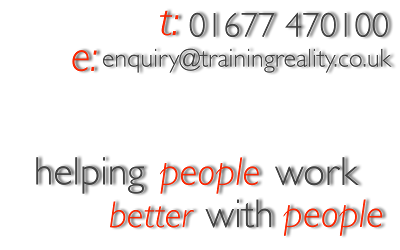Please press (at least!) one of these.
It costs you nothing, and (possibly) helps us spread the word!
Bad modelling
Tuesday, 24 November 2009
Management training is full of models, and some of them are very useful indeed. Used with care, and with a genuine acknowledgment that they are just models, not actually the real world themselves, they can provide helpful insight, alternative perspectives, and challenges to any preconceived views. But we do need to recognise them for what they are.
In the Sunday Times a couple of weeks ago, their was an article about the prospective changes to sex education in schools, driven by a desire to reduce the UK’s winning performance in the teenage pregnancy rates competition. One point that was made was that in Holland, where sex education is started much earlier than here (and is apparently fairly advanced and technical), the level of teen pregnancy is much lower.
This is a classic example of over-simplified modelling - and there are a couple of significant patterns that are often repeated in this process.
Single factor analysis
“A causes B in Holland, therefore if we put A into the UK, B will be caused”.
This reminds me of the move to 24 hour opening times for bars, where the same effect was seen. Our mainland European partners had bars and cafes open all night, and (often) a relaxed, chilled out culture that went along with these (lack of) drinking regulations. Surely, if you applied these regulations into the UK, we too could have a continental cafe culture?
I’m yet to see this desirable effect, to be honest. Friday and Saturday nights (when I tend to be on taxi duty) still see the undesirable effects of too much booze consumed too quickly by too many.
In our complex world, with us as complex human beings, the chances of a single factor causing a particular effect, and being perfectly replicable, seem incredibly low.
Causality and correlation
“Holland has A and B. Therefore, A causes B”.
This is one of the classic mistakes of statistics - seeing that two variables are generally linked, and that therefore one causes the other. There are some wonderful examples of this failure of understanding. These examples below are statistically significant correlations - that is they tend to increase or decrease in line with (or in opposite terms to) each other, but I’d struggle to claim that one caused the other.
- Ownership of washing machines goes up at a similar rate to the likelihood of being involved in a car crash. Therefore owning a washing machine makes you more likely to have a car crash.
- As ice-cream sales increase, so do attacks on humans by sharks. Therefore, ice-cream sales cause shark attacks.
- As the number of people owning TV’s has increased, the record time for the mens 100 metres race has fallen. Therefore TV ownership increases athletic performance.
The point that these correlations are missing (in order to get to causality) is that there are third (fourth, or even fifth and beyond) factors involved, and that the direct correlations between the two variables does not mean that one causes the other.
For management training, and the modelling that goes along with it (I’m thinking about things like NLP, MBTI, Belbin, SDI and so on), these potential errors and ptifalls need to be paid close attention to.
It is far too easy to say “I do this because I’m an ESFJ” or “because I process visually, I can’t work well on the phone”. These over-simplifications in training, as in politics, are a common cause of misunderstanding, and ultimately disappointment.
Please press (at least!) one of these.
It costs you nothing, and (possibly) helps us spread the word!



